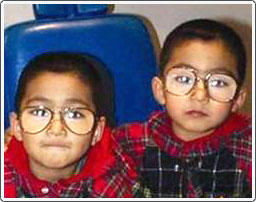Farsightedness is the common name for hypermetropia, or hyperopia. Most people think that farsighted people can see well only in the distance. In children, this is rarely true. However, in adults it is often the case, especially after the age of forty.
When we are born, our eyes have a baseline glasses prescription, as well as a tremendous capacity to focus. This doesn’t mean every one needs glasses at birth, it simply means that we all have a genetically pre-determined starting point when our eye development begins. In normal circumstances, we are usually born with excessive focusing power (usually 10-12 diopters). This means that children can tolerate much more farsightedness than adults, since the focusing power diminishes with time. The “need” for reading glasses arrives in the early forties, but varies depending on an individual’s particular “starting point.”

Twins with esotropia (crossed eyes) and hypermetropia. The glasses corrected the esotropia and they did not need surgery.
When does farsightedness need to be corrected? Normally, most doctors do not prescribe glasses unless there are significant symptoms such as decreased vision, headaches, eye strain or crossed eyes. In the event a child is non-verbal, glasses may be recommended based on the prescription obtained after dilating the eyes, a significant family history, crossing eyes, the child’s visual behavior during the exam, or any combination of these. A common glasses prescription in a farsighted child is between one and two diopters of farsightedness. This amount is easily focused by most children. However, there are instances when this is not the case, and there are children who are able to focus more than the average amount. Generally speaking, the average child can handle up to about four diopters of farsightedness without needing glasses; above this level, symptoms are usually present. Symptoms commonly occur when we have to use one-half of our “focusing reserve” (the 10-12 units mentioned above). Therefore, it stands to reason that an average child with a prescription of about four diopters would be able to focus fairly easily at a distance. However, when you add on the focusing required for reading (three diopters), giving you a total of seven diopters, “eye strain” is usually present.
Adults, around the age of forty, have about four to five diopters of “focusing reserve” left to use at near. Regardless of their glasses prescription for seeing clearly at a distance, at this age we have begun to exceed our comfortable “focusing reserve.” Our initial symptoms may be blurriness, headache, or eye strain. These symptoms are the same in children and adults. Glasses or contact lenses bring great relief of this discomfort.
Can one grow out of farsightedness?
This question is often asked by parents whose child is prescribed glasses at an early age. The answer is yes, although this is not always the case. As a rule, most children will “grow out” of three to four diopters of farsightedness at some point. However, it is almost impossible to determine ahead of time if one child will outgrow their glasses, whereas another child may not. There is wide variability, and no one can say for sure what the outcome for farsightedness will be.

